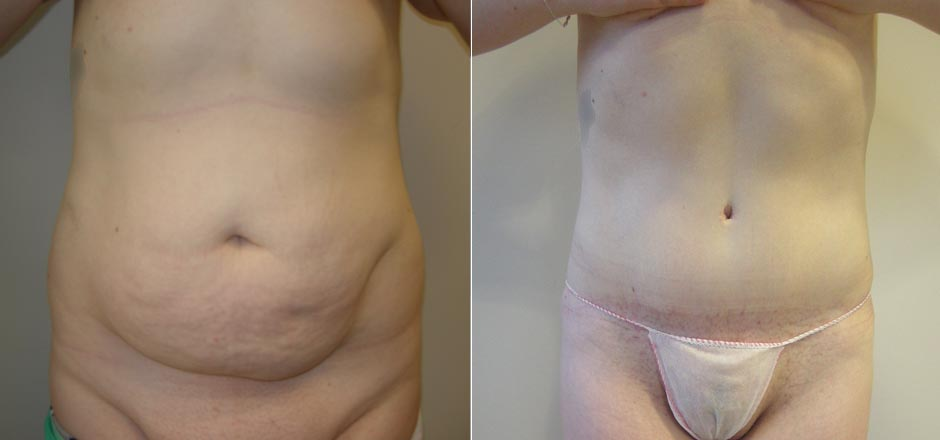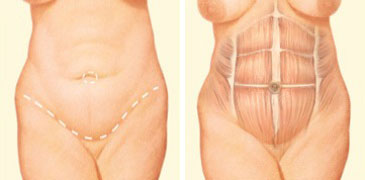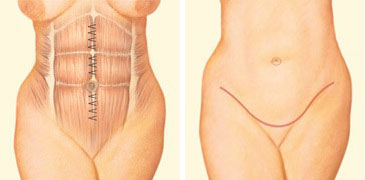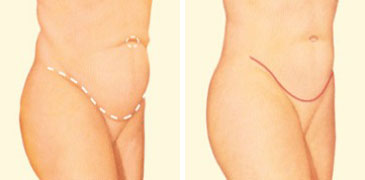If you’re considering a tummy tuck, you’re probably already thinking about how it will help you look and feel better. But before you commit to an invasive surgery, it’s important to consider what a tummy tuck actually does.
A tummy tuck is a surgical procedure that removes excess skin and fat from the abdomen and tightens the abdominal muscles. The surgery is often done to improve the appearance of loose skin after significant weight loss, but it can also be performed for other reasons, including poor muscle tone or trauma to the abdomen.
But there’s more to a tummy tuck than just getting rid of excess skin and tightening up your belly button. You should also consider whether your reason for wanting one is valid—and whether or not it will have lasting effects on your health.

What is a tummy tuck?
Formally known as abdominoplasty, the tummy tuck is a surgical body contouring procedure designed to improve the appearance of the abdomen by removing excess skin and, in some cases, tightening the underlying abdominal muscles. Oftentimes, the surgeon will combine liposuction with a tummy tuck to remove stubborn areas of fat and further enhance the results of the procedure.
Why it’s done
There are a number of reasons you might have excess fat, poor elasticity of the skin or weakened connective tissue in your abdomen. These include:
- Significant changes in weight
- Pregnancy
- Abdominal surgery, such as a C-section
- Aging
- Your natural body type
A tummy tuck can remove loose, excess skin and fat, and tighten weak fascia. A tummy tuck may also remove stretch marks and excess skin in the lower abdomen below the bellybutton. However, a tummy tuck won’t correct stretch marks outside of this area.
If you’ve previously had a C-section, your plastic surgeon might be able to incorporate your existing C-section scar into your tummy tuck scar.
A tummy tuck can also be done in combination with other body contouring cosmetic procedures, such as breast surgery. If you’ve had fat removed from your abdomen (liposuction), you may decide to have a tummy tuck because liposuction removes tissue just under the skin and fat but not any excess skin.
A tummy tuck isn’t for everyone. Your doctor might caution against a tummy tuck if you:
- Plan to lose a significant amount of weight
- Might consider pregnancy in the future
- Have a severe chronic condition, such as heart disease or diabetes
- Have a body mass index that’s greater than 30
- Smoke
- Have had a previous abdominal surgery that caused significant scar tissue
Types of tummy tuck surgeries
A cosmetic surgeon may recommend one of the following tummy tuck surgery procedures to help give you a firmer, flatter, abdominal contour with minimal scarring:
Mini Tummy Tuck: If you’re mainly concerned about stretch marks and loose skin below your belly button, then the mini tummy tuck surgery is the ideal option. This procedure involves making one horizontal incision below your belly button, from which your surgeon then effectively tightens the loose abdominal muscles. Surplus skin is also removed to create a flat and firm abdominal wall.
Mini tummy tuck surgeries usually take a relatively shorter time and will often have a faster recovery time, along with minimal scarring. Expect a thin scar, usually a couple of inches, along with a firmer and flatter lower abdomen.
Full or Classic Tummy Tuck: This tummy tuck addresses both the upper and lower abdomen areas and will typically yield great results in removing excess fat. Your cosmetic surgeon will use either a U-shaped or horizontal incision below the belly button or the navel. Excess fat and skin are then eliminated to achieve a slim abdomen that looks natural.
The full or classic tummy tuck will typically leave a longer scar due to the extensive incisions required. However, the scar will hide below a swimsuit bottom. This type of tummy tuck benefits includes a considerably smoother, slimmer abdomen with fewer stretch marks and more comfort wearing skirts and pants.
Extended Tummy Tuck: The extended abdominoplasty is the standard tummy tuck that includes recontouring the flanks, hips, or even lateral thigh. It is quite useful for those who have experienced significant weight loss and are now dealing with excessively saggy skin on their abdomen. In most cases, the surgeon will perform liposuction around the flanks during the tummy tuck.
Risks
A tummy tuck poses various risks, including:
- Fluid accumulation beneath the skin (seroma). Drainage tubes left in place after surgery can help reduce the risk of excess fluid. Your doctor might also remove fluid after surgery using a needle and syringe.
- Poor wound healing. Sometimes areas along the incision line heal poorly or begin to separate. You might be given antibiotics during and after surgery to prevent an infection.
- Unexpected scarring. The incision scar from a tummy tuck is permanent, but it’s typically placed along the easily hidden bikini line. The length and visibility of the scar varies from person to person.
- Tissue damage. During a tummy tuck, fatty tissue deep within your skin in the abdominal area might get damaged or die. Smoking increases the risk of tissue damage. Depending on the size of the area, tissue might heal on its own or require a surgical touch-up procedure.
- Changes in skin sensation. During a tummy tuck, the repositioning of your abdominal tissues can affect the nerves in the abdominal area, and infrequently, in the upper thighs. You’ll likely feel some reduced sensation or numbness. This usually diminishes in the months after the procedure.
Like any other type of major surgery, a tummy tuck poses a risk of bleeding, infection and an adverse reaction to anesthesia.

How you prepare
You’ll talk to a plastic surgeon about a tummy tuck. During your first visit, your plastic surgeon will likely:
- Review your medical history. Be prepared to answer questions about current and past medical conditions. Talk about any medications you’re taking or have taken recently, as well as any surgeries you’ve had.Tell your doctor if you are allergic to any medications. If your desire for a tummy tuck is related to weight loss, your doctor will likely ask detailed questions about your weight gain and loss.
- Do a physical exam. To determine your treatment options, the doctor will examine your abdomen. The doctor might also take pictures of your abdomen for your medical record.
- Discuss your expectations. Explain why you want a tummy tuck, and what you’re hoping for in terms of appearance after the procedure. Make sure you understand the benefits and risks of the procedure, including scarring. Keep in mind that previous abdominal surgery might limit your results.
Before a tummy tuck you might also need to:
- Stop smoking. Smoking decreases blood flow in the skin and can slow the healing process. In addition, smoking increases the risk of tissue damage. If you smoke, your doctor will recommend that you stop smoking before surgery and during recovery.
- Avoid certain medications. You’ll likely need to avoid taking aspirin, anti-inflammatory drugs and herbal supplements, which can increase bleeding.
- Maintain a stable weight. Ideally, you’ll maintain a stable weight for at least 12 months before having a tummy tuck. If you’re severely overweight, your doctor will recommend that you lose weight before the procedure. Significant weight loss after the procedure can diminish your results.
- Arrange for help during recovery. Make plans for someone to drive you home after you leave the hospital and stay with you for at least the first night of your recovery at home.
Steps of a tummy tuck procedure
Step 1 – Anesthesia
Medications are administered for your comfort during the surgical procedures. The choices include intravenous sedation and general anesthesia. Your doctor will recommend the best choice for you.
Step 2 – The incision
A full tummy tuck requires a horizontally-oriented incision in the area between the pubic hairline and belly button.

The shape and length of the incision will be determined by the amount of excess skin. Once the abdominal skin is lifted, the underlying weakened abdominal muscles are repaired.
A second incision around the navel may be necessary to remove excess skin in the upper abdomen.

The upper abdominal skin is pulled down like a window shade. The excess skin is trimmed and the remaining skin is sutured together. A new opening for the belly button is created. The belly button is popped through to the surface and sutured into position.

Step 3 – Closing the incisions
Sutures, skin adhesives, tapes or clips close the skin incisions.
Step 4 – See the results
Your tummy tuck will result in a flatter, firmer abdominal contour that is more proportionate with your body type and weight. Get more information about tummy tuck results.
Where Do They Cut For A Tummy Tuck
The main incision for a tummy tuck is made just above the pubic hairline, but can extend down to your groin area as well. It’s a horizontal incision that runs across your abdomen, starting at one side and ending on the other. A vertical incision is made on each side of this horizontal cut, extending down to where your original belly button was located.
When will i feel normal after tummy tuck?
Let’s be honest…A tummy tuck is a big operation and you can expect it to take a couple of months before you get back to normal. There are many types of tummy tucks, and the recovery time can vary depending on the extent of the surgery.
Tummy tuck recovery stages
Below, you’ll find a handy timeline for what to expect after tummy tuck surgery. Again, keep in mind the extent of your surgery can vary. For example, a mini tummy tuck is far less invasive than an extended Sculpt tummy tuck, which means a shorter recovery time. Your mileage may vary.
Now that we’ve said that, let’s dive into a typical tummy tuck recovery timeline that you may find useful as you prepare for tummy tuck surgery:
Week 1: This is no doubt the most difficult part of tummy tuck recovery. Tummy tuck pain, swelling and even bruising are common.You may even regret having a tummy tuck. Don’t worry – these feelings are normal and this, too, shall pass.
You’ll be walking bent over at this point, and will be spending most of your time resting from the comfort of your bed or sofa. Walking every day is vital to recovery. Even just a few minutes every few hours can help.
Driving is off limits for the first 2-3 weeks.
At the 7 day mark, you will come in for a follow-up appointment. Dr. Beldholm will change the PICO dressings. Click here to learn the benefits of PICO negative pressure dressings.
Week 2: The worst is behind you. You’ll still have some discomfort, but it will decrease day by day. Swelling is still prevalent. Numbness in the lower abdomen is also normal. Your tummy still feels tender, so you will likely still need help around the house from friends, family members or an aid. By day 10, most patients will start walking upright. You’re doing great. Hang in there!
Week 3: Congrats! Most patients are allowed to start driving after a tummy tuck at 2 to 3 weeks. Now that you can drive, it frees you up to have a lot more independence. You’ll still need assistance carrying heavy groceries, etc. at this point, though. By now, you should be feeling a lot better overall.
Swelling, discomfort and bruising will decrease greatly by this stage.
The lower tummy will most likely still be numb and feel a bit “alien” for the time being. That’s because the sensory nerves in the skin were damaged during surgery (this is normal, after all, you just had surgery). Feeling will return eventually. Numbness usually subsides within 3 months as the nerves repair themselves.
Week 4: Most patients return to work around 4 weeks post-op. Returning to work signals how far you have made it in recovery. It also helps patients feel good knowing they are back in a familiar routine, so you will start to feel more “normal” again.
Week 5-8: Each day is easier and easier. You will be amazed at how far you have come in such a short time. The worst of the swelling will start going away 1 to 2 months after surgery. Most patients can resume a full exercise routine at the 8-week mark.
Exercising after tummy tuck is beneficial. It not only shows how far you have come physically, but exercise can also improve your tummy tuck results by keeping you fit and healthy. You’ll also be able to handle lifting heavy objects like groceries without assistance, which makes life easier.
Week 9: You’ve made it to the 3-month mark. This is when most of Dr. Beldholm’s patients say they really start feeling “back to normal”. Some swelling will still be present, but it will be substantially less than it was a few weeks ago. There shouldn’t be any pain or discomfort at this stage and you will be completely independent. The scars will still be red at this stage. It can take a long time for surgical scars to mature.
In the weeks and months that follow, you will notice swelling reduce even more. As the swelling settles, your tummy tuck results will become more visible. It’s amazing to see the transformation that takes place.
Remember, just a few months ago you had a totally different body with loose skin and unwanted fat that made you feel pretty low. Clothes will fit better now, and you will start feeling more like yourself as you get used to your beautiful, flat tummy
How long until I see the results of a tummy tuck?
Getting a tummy tuck is a big landmark in many patients’ lives. It is no wonder that they feel both excited and anxious to see the results of surgery. After all, it took a lot of time and effort finding the right surgeon, taking time off work, arranging rides to doctor appointments, etc. Not to mention, the cost of tummy tuck surgery.
After all that, of course patients wish they could see results right away. The truth is, you will see a noticeable improvement immediately after surgery. That unwanted loose skin and fat will finally be gone for good. But — and this is a BIG “but” — it takes a while to see the final results because of the swelling after surgery.
In Doctor Bernard’s experience, 12 to 18 months is how long it takes to see the final results of tummy tuck surgery. However, you will feel “normal” again by the 3-month mark.
Tummy tuck scar fading is usually what takes the longest. (Hint: If you want to fade tummy tuck scars faster, try Laser Genesis to reduce scar redness.)
Is a tummy tuck covered by insurance?
Although there are certainly medical and functional benefits to be gained through a tummy tuck, the procedure is not typically covered by insurance. Some related procedures, such as the panniculectomy – which is used to remove the excess skin of the pannus after weight loss – may be covered by insurance in certain cases.
Where are tummy tuck scars?
Pelvic area
Regardless of whether you had a mini or full tummy tuck, you’ll have a scar that runs horizontally across your lower abdomen from hip to hip, located a few centimetres below your belly button. The horizontal scar can vary in length. It may be just a few centimetres, which is often the case for mini tucks, or extend well over each hip to the sides of your back. The scar may also be placed in relatively the same spot where a C-section was.
Belly button
Full abdominoplasty involves a scar around your belly button. This scar may be quite noticeable at first, but with time, you’ll notice that it virtually disappears because it blends in so well with your belly button.
Lower abdomen
In rare cases, you may also have a scar that runs from your belly button vertically down to the horizontal incision.
Can I combine a tummy tuck with other procedures?
Yes! Many patients choose to combine their tummy tuck with additional procedures in order to maximize the results of their transformation as well as to cut down on expensive surgical fees in the long run. After weight loss patients may choose to have a tummy tuck, arm lift (brachioplasty), and thigh lift all performed simultaneously, for instance.
Another example of a combined procedure is the mommy makeover, which can be highly beneficial for women who have had children – and even those who haven’t. Some of the procedures most commonly combined with a tummy tuck as part of a mommy makeover include breast augmentation, breast lift, and Brazilian butt lift (BBL).
